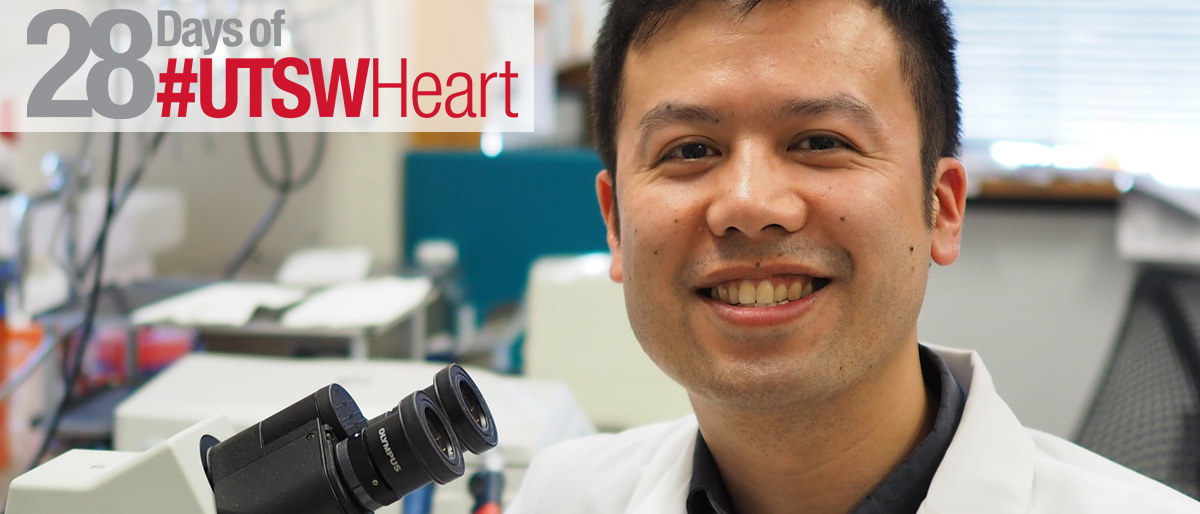Haberecht Grant supports 'Wildhare-Idea' in cardiac research

Dr. Nicholas Lam, a postdoctoral fellow in the lab of Dr. Hesham Sadek, has been awarded the 2018-2019 Haberecht Wildhare-Idea Research Grant for his work on a novel strategy to enable heart muscle cells to regenerate.
“The Haberecht Grant supports a ‘hare-brained’ speculative idea that, if correct, would constitute a breakthrough in biomedical research,” said Dr. Andrew Zinn, Dean of the Graduate School of Biomedical Sciences.
A committee of eminent scientists recruited by Dr. Zinn selected Dr. Lam’s project – “Inducing Cytokinesis in Binuclear Cardiomyocytes to Promote Heart Regeneration” – to receive the one-year, $25,000 award from among 29 proposals from faculty, postdoctoral fellows, and graduate students.
“I am humbled and honored by this award, and it is validating to know that my research idea is good,” Dr. Lam said. “This provides the seed funding for me to test it out.”
Heart failure affects some 26 million people worldwide. About 5.7 million American adults have heart failure, costing the nation an estimated $30.7 billion a year, according to the Centers for Disease Control and Prevention.
“The inability of the adult heart to regenerate is the underpinning of systolic heart failure, the most common form of heart failure,” Dr. Lam said. “In contrast to adult mammals, our group, in collaboration with Dr. Eric Olson’s lab, recently showed that neonatal mouse hearts have a significant intrinsic regenerative capacity, mediated by proliferation of pre-existing cardiomyocytes – heart muscle cells – and is lost within the first week of life as cardiomyocytes exit the cell cycle.”
A few days after birth, most heart muscle cells in mice undergo a burst of DNA synthesis without cytokinesis, the cytoplasmic division of the cell that brings about two daughter cells. This leads to the end of the cell cycle and binucleation – the formation of two nuclei in a cell without the division of the cytoplasm – in 88-95 percent of cardiomyocytes in 7-day-old to adult mice, which means the heart can no longer undergo meaningful regeneration following significant cardiac injury, he said.
“Cytokinesis is the last step in the eukaryotic cell cycle that physically separates two nuclei into two daughter cells. From a cell biology perspective, it is not known if binuclear cells can undergo cytokinesis to become two mononuclear daughter cells.”
But that is exactly what Dr. Lam hopes to find out. His unexplored strategy is based on several key phenomena: The majority of cardiomyocytes in the adult heart are binuclear, meaning they have two nuclei. These binuclear cardiomyocytes have sufficient genetic material for two cells. In addition, binuclear cardiomyocytes are formed from karyokinesis (the division of the cell’s nucleus) without cytokinesis (the division of the cell’s cytoplasm).
“If our hypothesis that multinuclear cardiomyocytes can be forced to undergo cytokinesis is correct, this hare-brained idea would be the basis for a giant step in biomedical research by potentially doubling the number of total cardiomyocytes in the heart – sufficient to meaningfully regenerate the heart to prevent the onset of or reverse heart failure,” Dr. Lam said.
“Nick is an exceptionally creative scientist,” said Dr. Sadek, Associate Professor of Internal Medicine and Molecular Biology and Associate Director of the Hamon Center for Regenerative Science and Medicine. “This type of unconventional thinking is the cornerstone of transformative discoveries.”
A native of Melbourne, Australia, Dr. Lam earned a Bachelor of Biomedical Science in reproduction and developmental biology from the University of Melbourne and a Ph.D. in cardiac regeneration from Monash University. UTSW was the logical next step in Dr. Lam’s career path: “Dr. Sadek is a world leader in cardiac regeneration, and I wanted to train from the best,” he said.
Dr. Olson is Chair of Molecular Biology and Director of the Hamon Center for Regenerative Science and Medicine. He holds the Pogue Distinguished Chair in Research on Cardiac Birth Defects, The Robert A. Welch Distinguished Chair in Science, and the Annie and Willie Nelson Professorship in Stem Cell Research.
Dr. Sadek holds the J. Fred Schoellkopf, Jr. Chair in Cardiology.
Dr. Zinn holds the Rolf Haberecht and Ute Schwarz Haberecht Deanship of the UT Southwestern Graduate School of Biomedical Sciences.

